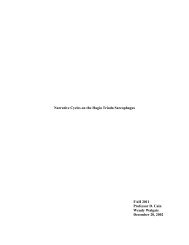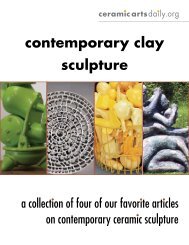You also want an ePaper? Increase the reach of your titles
YUMPU automatically turns print PDFs into web optimized ePapers that Google loves.
interior; elements of form and colour that become the eavestroughing that runs around the<br />
perimeter of a Gaudi roof - and so I discovered roofs and how they could influence the<br />
building of my pots.<br />
The future holds the further investigation of three-dimensional space around the pieces I<br />
construct. For example, within the design of the arms, lids and bases of the linear vases,<br />
there is a possibility of moving outward from the axis line. Free-standing forms can<br />
interact or connect in some way with the central vase shape. I am even tempted to refer to<br />
the flying buttresses of one of Gaudi's interior roof supports to produce a base system that<br />
holds a vase in its raised centre.<br />
My natural tendency is towards a symmetrical form, especially in the larger vases which<br />
depend on an equally balanced weight to remain erect. But through the flow of surface<br />
design and glaze I have tried to impose a contrasting movement that the eye can follow<br />
around the form. Symmetry in the vase forms indicates to me, a completed and<br />
monumental appearance and is part of the work's visual strength and content.<br />
Articulation of Inner and Outer Space, Philip Rawson, Ceramics<br />
Monthly, December 1986 (pg. 27):<br />
Like architecture, ceramics uses physical codes to mark out<br />
shapes of linear flow - stepwise interval and transition from<br />
volume to volume. They can consist of lines and linear surfaces,<br />
angular breaks in the surface in or out - shoulder, flanges,<br />
flutings, cuts or steps. They can be ripples, finger striations,<br />
irregular undulations, humps or hollows, appliques, lumps or<br />
actual holes. They can be structural components of various sizes:<br />
added features such as handles or knobs: relative proportions of<br />
height to widths. They can be differentiated volumes. And they can<br />
be glazed or painted ornamental features. From these we read the<br />
vessel's implicit energies.<br />
Volume is one word that Tony is always urging me to consider.<br />
My fingers tend to work in a very compressive way. Press-moulding, pushing clay into<br />
the insides of forms, I am defining the exterior limits, not the interior ones. Occasionally I<br />
use thrown forms in the centre of my vase shapes and a sense of volume is achieved by<br />
pushing out on the interior walls with my fingers.<br />
Another method I am using is to cut into blank clay slab walls on pots to reveal interior<br />
spaces, frame sections with open scroll work or use perforated sheets of clay as a screen<br />
to look through. I try to allow the work to breath and have a corresponding interior and<br />
exterior that are responsive and sensual.<br />
24





